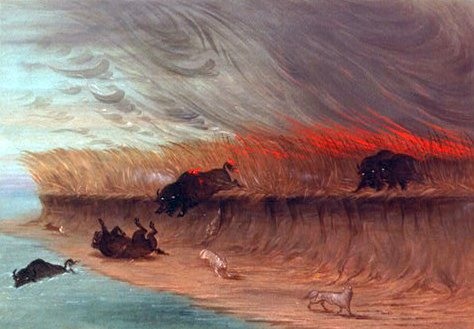Buffalo Tales: The Near-Extermination of the American Bison
Shepard Krech III, Brown University
©National Humanities Center |
|
(part 3 of 4)
 |
George Catlin
Prairie Meadows Burning
1861/1869
| National Gallery of Art |
|
|
 |
The decline of the buffalo is largely a nineteenth-century story. The size of the herds was affected by predation (by humans and wolves), disease, fires, climate, competition from horses, the market, and other factors. Fires often swept the grasslands, sometimes maiming and killing buffaloes. Millions of horses in Indian herds competed for grasses. Drought was perhaps most significant; severe prior to the fifteenth century, and episodic in the eighteenth, it might have been worst at the very moment when other pressures converged in the early years of the decades from 1840 to 1880.
Yet no matter the impact from drought, horses, or fires, what doomed the buffalo most were (1) the commodities markets for buffalo tongues, skins, meat, and robes; and (2) the railroads, which provided the means of transportation to rapidly expanding European-American populations.
 |
 |
"Wanton Destruction of Buffalo"
in W. E. Webb, Buffalo Land, 1872
enlarge image
|
|
 |
Again largely a nineteenth-century tale, the final stage from 1867 to 1884 was notable for the fury of the slaughter for hides and other products. In 1867 the first of five railroads split the herd in the heart of buffalo range, a process repeated again and again. Provisioners like Buffalo Bill Cody, sportsmen, farmers, and ranchers who craved the prairies for crops and cattle—all placed new pressure on bison. The railroads made transportation of buffalo hides easy and cheap, so market hunters flooded in, wasting three to five times the numbers they killed. The carnage from herds already depleted by other factors defied description: 4-5 million killed in three years alone. The commercial hunt was finished by the fall of 1883.
|
National Archives  |
Hide yard with 40,000 buffalo hides
Dodge City, Kansas, 1878
enlarge image
|
|
 |
Indians, confined to reservations and distressed from hunger, took part until the bitter end—the Piegan until "the tail of the last buffalo" disappeared. The final shipment of hides took place in 1884. With very few exceptions, the buffalo was gone and bone collectors scooped up all the remains they could find for shipment east where they were processed into phosphate fertilizer.
 |
1870
|
National Archives |
|
Thirty years ago millions of the great unwieldy animals existed on this continent. Innumerable droves roamed, comparatively undisturbed and unmolested, . . . Many thousands have been ruthlessly and shamefully slain every season for past twenty years or more by white hunters and tourists merely for their robes, and in sheer wanton sport, and their huge carcasses left to fester and rot, and their bleached skeletons to strew the deserts and lonely plains.
"In the Prime of the Buffalo," J. F. Baltimore
The Overland Monthly and Out West Magazine
November 1889
full text
|
|
Today, one hundred years later, the buffalo has returned from the brink of extinction to roam the grasslands again in Yellowstone and beyond. Feared by farmers for diseases like brucellosis that they might carry to cattle herds, their fate beyond Yellowstone is uncertain, although Indian people have joined forces in a cooperative effort to save animals wandering from Yellowstone from the rifle, and to raise viable herds of this formerly vital, and currently deeply symbolic, animal. Yet it is no coincidence that in today's changing economy, when many Indians talk of the return of the buffalo, they mean not the animal but casinos.
 |
Carsi/CAS
|
|
|






